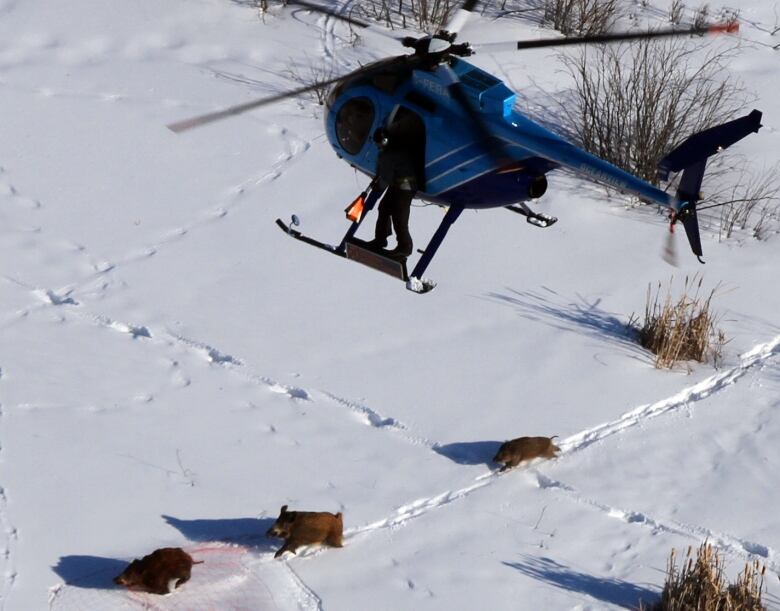Ontario calls wild pigs 'ecological trainwreck.' Now it wants a plan to keep them out
Sask. expert gives credit to Ontario aim to add wild pigs, 12 other invasive species to special watch list

Wildlife officials in Ontario are drafting a new strategy to keep wild pigs from establishing themselves in the province, to prevent what officials have referred to as an "ecological train wreck."
The province published its proposal on Wednesday, asking hunters, trappers and other outdoor enthusiasts for their inputintohow to deal with a potential porcine invasion, should it arrive.
"Based on experiences from other jurisdictions, it is clear that the least costly and most effective approach for managing wild pigs is to act early," the Ontario government website said.
The proposal seeks to add wild pigs, along with 12 other invasive species, to the Ontario Invasive Species Act, giving authorities more means at their disposal to eradicate the wily and elusive animals.
The new regulations would alsoban the release of pigs into the wild.
The Ministry of Natural Resources and Forestry (MNRF)is drafting protocols inthe event a pig escapes from a farm or transport truck, so itcan be notified immediately, and the animal can be recaptured or dispatched as soon as possible.
Sask. expert says Ontario on right track
Ontario's announcement Wednesdayfollows the introduction of a wild pig protocol this spring by the Ontario Federation of Anglers and Hunters (OFAH) to helphunters, trappers and outdoor enthusiasts properly identify the animals and report their locations to the MNRF.

"Once they become established, it's virtually unheard of to get rid of them. If they become widespread in a place like Ontario, there's virtually no chance of eradication," said RyanBrook, a wild pig expert and an associate professor at the University of Saskatchewan.
"We've missed that window in Saskatchewan.I think Ontario is in a good position to get on it. If I were grading this as a project, I would give them an A-plus for effort."
Brook and his team havebeen studying wild pigs in Canada for 11 years. He said there is so far no evidence of any established populations in Ontario, and the provinceis doing the right thing by showing leadership on the issueand acting early.
"I would argue they are the worst invasive large mammal on the planet. They have an amazing ability to reproduce," he said."A small problem can turn into a massive out-of-control problem very quickly."
"They can be very large. They're very dangerous to people. They have razor-sharp tusks. They can be aggressive and they're highly mobile, and they're incredibly smart. So all those characteristics and the fact that they will eat literally almost anything means they will be very successful."
React 'as soon as you find pigs'
Brook said wild pigs were introduced to Saskatchewan many years ago when a tractor-trailer carrying a load of domestic wild boaracross the province crashed. The 11 animals on board escaped and only seven were recovered.
"There was four that went into a park and they turned into well over 100 animals in a few years," he said.
Brook said Saskatchewan has tried a number of methods to eradicate wild pigs without success, including traps and highly trained ground teams who quickly go into an area and physically remove the pigs.
In his studies of wild pigs, Brook has travelled to other jurisdictions, including the United States, to see how other places have handled the problem, and in all of them, he's seen only one common thread for dealing with the animal effectively.
"You need really good leadership that's going to make tough decisions. You need to be monitoring very hard, and as soon as you find pigs, you have to react."
'Active surveilliance' needed for eradication
Brook said that,more than any other province, Ontario is showing solid leadership on the wild pig issue and is embracing a science-based approach.

"I think eradication is on the table, but it will still take major effort,especially through active surveillance," said Brook.
He said most jurisdictions rely on passive surveillance, by encouraging hunters, trappers and anglers to report pig sightings to a tip line.
Ontario just recently added wild pigs to the list of animals that can be reported to its invasive species tip line.
But Brook said finding wild pigs is more complicated than just sitting by the phone.
The more proactive we are and aggressive we are in searching out those pigs, the better.- Ryan Brook, University of Saskatchewan, wild pig expert
"'We'll wait and you call us,' that's useful, but we've found in our research here in the Prairies that you probably only get one to three per cent of actual pig sightings from that. The overwhelming majority of pig sightings we have is by putting out trail cameras or going out and knocking on doors."
Brook said pigs are nocturnal, elusive and often hide in thick cover, making underground burrows or nesting among cattails in wetlands, spruce trees in forests and building what he calls "pigloos" in the winter.
"They tunnel into snowbanks and make almost like an igloo," he said, noting he's fitted pigs with radio collars, and even with the aid of satellites and a helicopter, still wasn't able to spot them with his own eyes.
"They're very hard to find," said Brook.
"I don't think we should pretend this is easy. The more proactive we are and aggressive we are in searching out those pigs, the better."












_(720p).jpg)


 OFFICIAL HD MUSIC VIDEO.jpg)
.jpg)



























































































